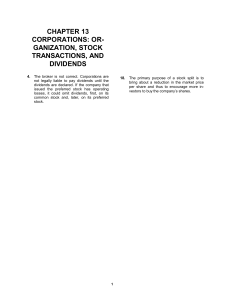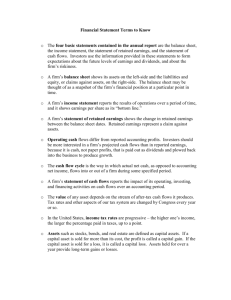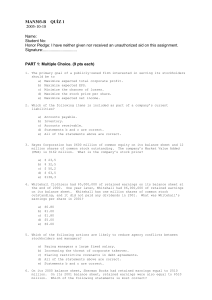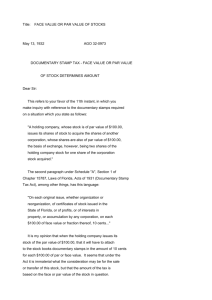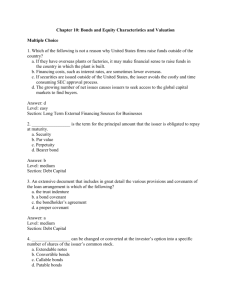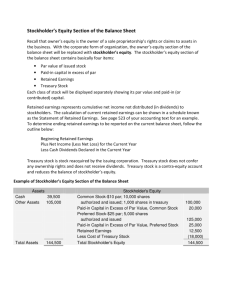Exam #4 - Accounting
advertisement
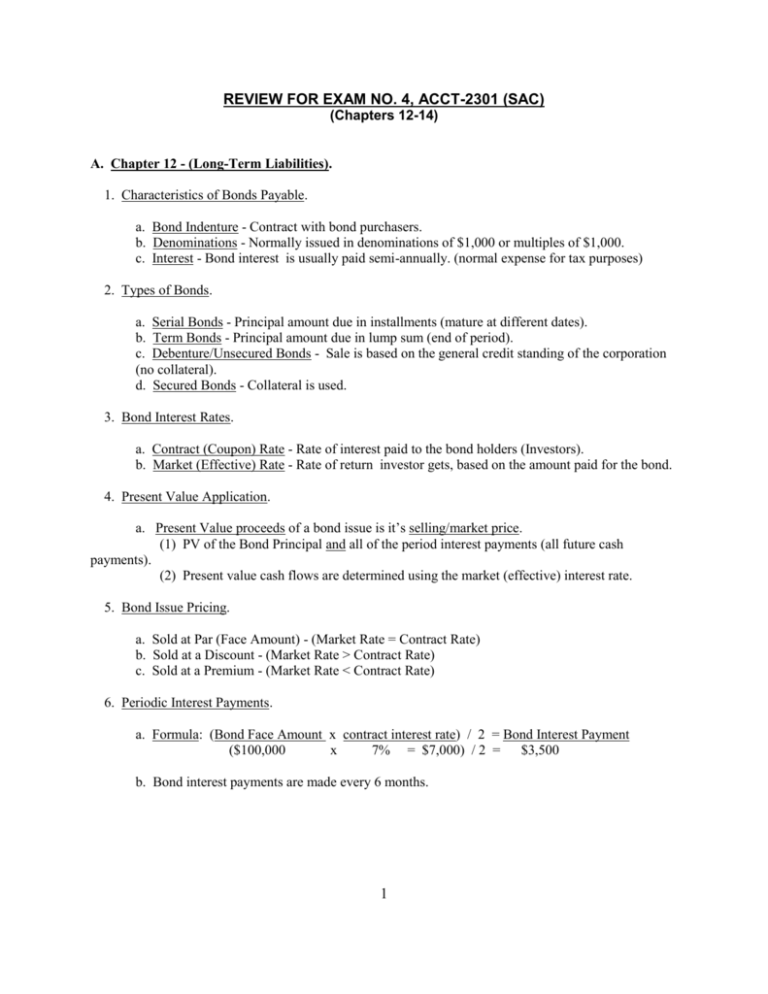
REVIEW FOR EXAM NO. 4, ACCT-2301 (SAC) (Chapters 12-14) A. Chapter 12 - (Long-Term Liabilities). 1. Characteristics of Bonds Payable. a. Bond Indenture - Contract with bond purchasers. b. Denominations - Normally issued in denominations of $1,000 or multiples of $1,000. c. Interest - Bond interest is usually paid semi-annually. (normal expense for tax purposes) 2. Types of Bonds. a. Serial Bonds - Principal amount due in installments (mature at different dates). b. Term Bonds - Principal amount due in lump sum (end of period). c. Debenture/Unsecured Bonds - Sale is based on the general credit standing of the corporation (no collateral). d. Secured Bonds - Collateral is used. 3. Bond Interest Rates. a. Contract (Coupon) Rate - Rate of interest paid to the bond holders (Investors). b. Market (Effective) Rate - Rate of return investor gets, based on the amount paid for the bond. 4. Present Value Application. a. Present Value proceeds of a bond issue is it’s selling/market price. (1) PV of the Bond Principal and all of the period interest payments (all future cash payments). (2) Present value cash flows are determined using the market (effective) interest rate. 5. Bond Issue Pricing. a. Sold at Par (Face Amount) - (Market Rate = Contract Rate) b. Sold at a Discount - (Market Rate > Contract Rate) c. Sold at a Premium - (Market Rate < Contract Rate) 6. Periodic Interest Payments. a. Formula: (Bond Face Amount x contract interest rate) / 2 = Bond Interest Payment ($100,000 x 7% = $7,000) / 2 = $3,500 b. Bond interest payments are made every 6 months. 1 7. Amortization of Bond Discount/Premium. a. Straight-Line Method (constant amount of interest expense) Interest Expense = Cash Interest Payment + Discount Amount No. of Periods (Or) Interest Expense = Cash Interest Payment - Premium Amount No. of Periods b. Effective Interest Method (constant rate of interest) Interest Expense = Carrying Amount x Market Rate / 2 8. Bond Redemption. a. Callable Bonds - Bonds redeemable at option of the corporation (before maturity). b. Convertible Bonds - Bonds are redeemable at option of the investor. Bondholder has the option to convert bonds to common stock, at a specified ratio. c. Pay off face value at maturity. d. Purchase bonds on the open market. 9. Bond Journal Entries. (Pages 697 - 702) a. Issued at Par b. Issued at a Discount c. Issued at a Premium 10. Bond Trading. a. Buying and selling on the bond exchanges. b. Bond prices (market value) are expressed as a percentage of their par (face) value. For example, a $1,000 bond trading at 103 ½ means that it can be sold at 103.5% of par value, or $1,035. B. Chapter 13 (Stockholders Equity): 1. Corporate Organization. a. Formation. (1) Application for incorporation. (2) State grants Charter or Articles of Incorporation. (3) By-laws: rules and procedures of the corporation. (4) Organization costs - expenses of forming a corporation. 2 b. Structure. (1) Stockholders (Owners) (2) Board of Directors (Elected by Stockholders) (final authority for managing a corporation) (3) Officers (Appointed by the Board) (responsible for the day-to-day operations) (4) Employees 2. Stockholders Equity. a. Paid-In Capital (Contributed Capital): (1) Common or Preferred Stock (Par Value) (2) Paid-In Capital in Excess of Par b. Retained Earnings. (1) Accumulated earnings from operations (less any dividends), retained in the corporation since it’s inception. (2) Deficit - Negative retained earnings (account debit balance). c. Rights of Common Stockholders. (1) Vote (may be by proxy) (2) Preemptive right (first opportunity to purchase additional shares offered to the public) (3) Share in distribution of earnings - Dividends (4) Right to share residual assets upon liquidation 3. Stock. a. Authorized Stock. (1) Contained in Corporation Charter (2) Usually more shares authorized than number anticipated for first issue. b. Classes of Stock: (1) Common (basic corporate stock - required) (2) Preferred c. Accounting for Issuance. (1) Stock may be issued for cash or other assets. (2) Asset value received (cash or other) compared to par value, may result in a premium or a discount. (3) Minimum Legal Capital: (a) Par or stated value of the shares issued. (b) Does not establish stock worth or price. (c) Amount that must be left invested in a corporation to protect it’s creditors. (4) Journal Entries: (a) Issues at Par (b) Issues above Par (Premium) (c) Issues of No-Par (Unstated or Stated Values) (d) Issues for other assets (use the fair market value of asset or the fair market value of the stock, whichever can be determined more objectively) 3 d. Preferred Stock Characteristics. (1) Preferences - Granted to owners (commonly for dividends) (2) Voting Rights - Usually none (3) Convertible - Provides for exchange of preferred stock for common stock at a specific ratio (i.e., 1:10), at the option of the shareholder. (4) Callable - Gives issuing corporation the option to retire shares at a specific price. e. Preferred Stock Dividends. (1) Receive dividends before Common Stock does. (2) Cumulative - Undeclared dividends accumulate until paid. (3) Non-Cumulative - Right to receive dividends is forfeited for any year not declared. 4. Stock Values. a. Market Value - Price at which a share can be bought or sold on the market. b. Book Value - Equity represented by one share of common stock in corporation assets. Total Stockholders Equity - Preferred Dividends Outstanding Common Shares c. Par Value - Arbitrary value selected by the corporation and included in the corporate charter or articles of incorporation. Establishes corporate minimum legal capital. 5. Treasury Stock. a. Corporation's own stock that has been issued, reacquired by the corporation, and not canceled or reissued. b. Usually it is the intention of management to reissue (redistribute)treasury stock at a later date. c. Treasury stock is subtracted from stockholders equity on the Balance Sheet. (Contra-Equity Account) d. Par value is ignored in treasury transactions. All transactions are recorded and accounted for at actual cost (Cost Method). e. Any gains, on the sale of treasury stock, is credited the special equity account Paid-In Capital, Treasury Stock. f. Any losses, on the sale of treasury stock, is first applied against the Paid-In Capital, Treasury Stock Account, with any balance charged to Retained Earnings. g. Journal Entries. (Pages 765 - 767) 6. Stock Splits. a. Calling in shares and replacing them with a larger issue (multiple shares). b. Total par value of shares does not change. Par or stated value per share reduces (inversely with increase in the number shares). c. Only memo entry required to record the stock split. d. Retained earnings are not capitalized. 4 e. Number of shares increases and book value per share decreases. Applies to all shares (unissued, issued, and treasury). 5 7. Cash Dividends. a. Requirements for declaration of Dividends. (1) Sufficient cash must be available. (2) Sufficient retained earnings must be available. (3) Requires formal action by the Board of Directors. b. Cash Dividend Dates: (1) Declaration Date (formal Board action) (2) Date of Record (establishes dividend ownership) (3) Date of Payment (payment to shareholders) c. Dividends are not paid on Treasury Stock (only outstanding shares). d. Reduces Retained Earnings e. Journal Entries. (Pages 756 - 757) 8. Stock Dividends a. Proportional distribution to existing stockholders (based on shares issued/outstanding). (1) Small stock dividend (25% or less of outstanding shares). Capitalize retained earnings based on current market price of the stock. (2) Large stock dividend (more than 25% of outstanding shares) Capitalize retained earnings based on the par value of the stock. b. No assets are transferred from corporation to stockholders. c. Recorded by a Transfer of Retained Earnings: For public corporations, normally the amount transferred to paid-in capital is the fair market value of the shares issued in the stock dividend. d. Stock Dividends Distributable (Stockholders Equity Account). e. Journal Entries (Page 760) f. Stock Dividend Dates: (1) Declaration Date (formal Board action) (2) Date of Record (establishes ownership of shares of stock dividend) (3) Date of Distribution (issuance of the stock dividend shares) 9. Prior-Period Adjustments. a. Material errors, not discovered in the same period they occurred, are not included in the computation of net income for the current period. b. Such adjustments are reflected as adjustments to the Retained Earnings beginning balance in the period they are identified. c. Reported in the Statement of Retained Earnings. 6 C. Chapter 14 (Statement of Cash Flows). 1. Purposes. a. b. c. d. e. To predict future cash flows (ability to generate cash from operations). Provide information to maintain and expand operating capacity. To determine company’s ability to meet obligations (repay debts and interest). To determine ability to pay dividends. Reports all cash inflows and outflows for an accounting period. 2. Report Categories. a. Operating Activities b. Investing Activities c. Financing Activities 3. Methods for Preparing the Statement of Cash Flows. a. Direct Method - analyze each non-cash account and determine cash inflows and outflows. b. Indirect Method - starts with net income and adjusts for non-cash transactions to determine cash inflows and outflows. 4. Cash Definition. a. Includes cash and cash equivalents. b. Cash equivalents are highly liquid short-term investments that can be converted to cash with little delay. 5. Typical Cash Inflows and Outflows by Category. a. Exhibit 14-2 (Page 812) 6. Non-Cash Investing and Financing Activities. a. Reported on a separate schedule. b. Example – Acquisition of land and a building in exchange of common stock.. 7


